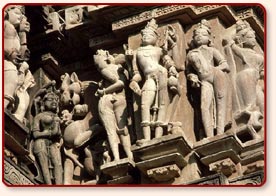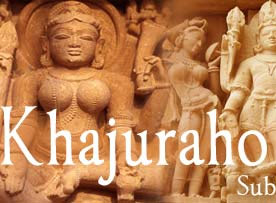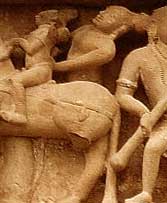 The past of Khajuraho is shrouded with mystery and
conjecture. In the midst of the wilderness full of ferocious animals,
there is the small town of Khajuraho standing alone in its solitude with
its ancient temples. With hardly any written records and rare references
to its origin, the history of Khajuraho has become trapped in the
mythical folklore of the region. The beautiful artwork of these temples
have gained the attention of the art lovers all over the world but the
real purpose behind their construction is a mere guess work of the
intellectuals. The These temples fire the imagination of the visitors
with innumerable questions such as their significance and their position
in the society, the reason behind using these temples as an art gallery,
the whereabouts of the said kingdom and why only the temples have been
found and there are no ruins of the mansions and palaces in the nearby
area. The graphic representation of sexual and erotic postures in a
religious place is bewildering too.
The past of Khajuraho is shrouded with mystery and
conjecture. In the midst of the wilderness full of ferocious animals,
there is the small town of Khajuraho standing alone in its solitude with
its ancient temples. With hardly any written records and rare references
to its origin, the history of Khajuraho has become trapped in the
mythical folklore of the region. The beautiful artwork of these temples
have gained the attention of the art lovers all over the world but the
real purpose behind their construction is a mere guess work of the
intellectuals. The These temples fire the imagination of the visitors
with innumerable questions such as their significance and their position
in the society, the reason behind using these temples as an art gallery,
the whereabouts of the said kingdom and why only the temples have been
found and there are no ruins of the mansions and palaces in the nearby
area. The graphic representation of sexual and erotic postures in a
religious place is bewildering too.However, if the myth it is to be believed, Khajuraho was known as 'Khajur-vahika' or 'Khajjurpura' in the ancient times because of its golden date palms (known as 'khajur') that lined the gates of this city. It has been mentioned in the Mahoba-khand of Chandbardai's (the famous medieval court poet) 'Prithviraj Raso' that Hemraj, the royal priest of Kashi (the old name for Varanasi), had an exceptionally beautiful daughter named Hemvati, who was unfortunately a child widow. One summer night, while she was bathing in a lotus-filled pond, the Moon God was so dazed by her beauty that he descended to earth in human form full of lust and passion and ravished her. Later, he repented when the distressed Hemvati threatened to curse him for ruining her honor and dignity and blessed her with a valiant son who would later become a king and build the temples of Khajuraho. Hemvati left her home and gave birth to a brave and strong boy child in the tiny village of Khajjurpura. The child was named Chandravarman and it is said that by the time he was 16 years old, the glorious boy was strong and skilled enough to kill tigers or lions with his bare hands. With the blessings of the Moon God, his father he became a mighty king and built the fortress at Kalinjar. Then heeding to his mother's wishes he built 85 legendary temples surrounded by lakes and gardens at Khajuraho and also performed the bhandya yagya, to wash away the sins of his mother.
Yet another version of the above legend raises Hemvati as a dutiful daughter who sacrificed all her happiness and dignity for her father. Mani Ram, the royal priest of Kalinjar, miscalculated once and declared the dark night as the full moon night or Purnamasi in front of the king. Hemvati, his widowed daughter could not bear the possibility of any stigma on her father's reputation and prayed to the Moon God to uphold the word of the priest. However, she had to pay a heavy price for her wish being granted when the Moon God who was smitten by the lady's beauty ravished her in return for his favor. When Mani Ram came to know of this entire incident, he was so ashamed and grief-stricken that he cursed himself and turned into a stone. However, Hemvati got pregnant with the tryst and gave birth to a virtuous son by the name of sage Chandrateya who is believed to be the founder of the Chandela dynasty. Chandelas worshipped the Mani Ram-turned-stone as Maniya Dev.









